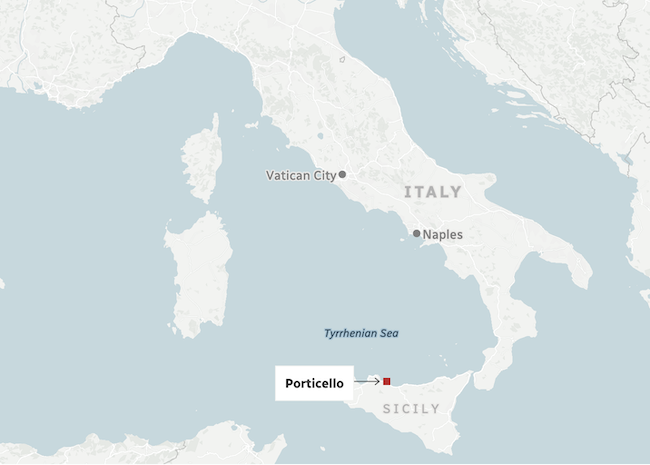Italy, Sicily: Superyacht Sinking Tragedy
The luxury superyacht “Bayesian” capsized and sank off the coast of Sicily during a storm on Monday 19 August. One crew member and 6 guests have been found dead out of the 22 people on board. Questions are being asked about why the vessel sank and how the weather conditions might have contributed to the tragedy.
Published 1 month ago, updated 3 weeks ago
Fifteen Rescued – Seven Dead
The 56m (183ft) British registered luxury yacht “Bayesian” was carrying 22 people (10 crew and 12 passsengers) including British, American, Canadian and New Zealand nationals.
The “Bayesian”, a Perini Navi, was anchored off the coastal village of Porticello, near the Sicilian capital of Palermo, when it sank in the early hours of the morning after a heavy storm that caused waterspouts to form. The yacht disappeared below the waterline at 0500 local time, sinking just a few minutes after it capsized to a 50m depth.
Fifteen passengers and crew were rescued while initially six passengers were missing. Searchers immediately recovered the body of one crew member not far from where the “Bayesian” sank, yacht chef Recaldo Thomas.
A specialist caving search and rescue diving team from Rome were tasked to search for the missing passengers, but were hampered by the depth the yacht had sunk to permitting only 10 minutes per dive for searching.
Ultimately they recovered the remaining missing bodies from inside the vessel. Officials have said the passengers who died—Michael and Hannah Lynch, Jonathan and Judy Bloomer and Chris and Neda Morvillo – were likely asleep at the time of the sinking.


What might have caused the yacht to sink?
Italian civil protection officials believe a sudden, intense storm that wreaked havoc along the northern coast of Sicily in the early hours of Monday morning, stimulated the creation of a waterspout in the exact spot where the “Bayesian” was moored.
Witnesses have reported that they saw the boat’s 72m aluminium mast snap during the freak storm, however divers attempting to recover the missing persons have reported that the yacht appears intact. Experts are speculating that the very large mast may have contributed to the anchored yacht capsizing, acting almost like a sail in the very strong wind and pushing the yacht over.
Other factors that contributed to the vessel sinking include water entering through hatches and doors, which had been left open because of warm weather off the Italian coast.
Well known sailor Skip Novak comments, “This just doesn’t happen. You know, boats sink because things like keels fall off, or they run aground and breach the hull … whereas just from a weather angle, a boat that big being pushed over on its side is absolutely extraordinary. When you’re at anchor, even if it’s blowing with a storm in the Mediterranean, you rarely shut the whole boat down because nobody expects something like this to happen,” Novak told The Associated Press. “So if the boat wasn’t completely watertight at the deck, you’d have flooding going in. It would take a couple minutes and that would be it.”
A neighbouring yacht crew rescued the 15 survivors from their life raft and alerted the Coast Guard.
There are numerous reports that Italian prosecutors will investigate James Cutfield, the captain of the Bayesian, for manslaughter. The investigation will look into if the crew of the ship appropriately handled the storm that hit the yacht before it capsized, if passengers were warned of imminent danger and if hatches on the ship were left ajar, which would have contributed to its quick sinking.
As part of the investigation, the yacht will be raised from the depths later this year, CNN reported, at the cost of registered owner Angela Bacares, the wife and mother, respectively, of victims Michael and Hannah Lynch.
Waterspout seen during storm
Witnesses have described seeing a waterspout form during the storm before the sinking of “Bayesian”. Waterspouts are like tornados – rotating columns of destructive winds, protruding from the base of clouds down to the ground. Waterspouts, however, are over water rather than land and instead of dust and debris swirling around the core of strong winds, it is water mist whipped up from the surface. Like tornadoes, waterspouts are only short-lived and their narrow column shape is not easily picked out on weather radars, so many go unreported.
In the northern hemisphere, waterspouts are most common in late summer and through the autumn, when sea temperatures are at their highest, fuelling the storm clouds. According to the International Centre for Waterspout Research there were 18 confirmed waterspouts off the coast of Italy on 19 August alone.
Violent and Unexpected Tempests
The shipwreck of the “Bayesian” is the latest sign that the Mediterranean is becoming a more tricky destination for cruisers.
Climatologists say global warming is making such violent and unexpected tempests more frequent in a sea used as a summer playground for millions of tourists, including a wealthy few sailing its waters on superyachts.
Luca Mercalli, president of Italy’s meteorological society, said the sea surface temperature around Sicily in the days leading up to the shipwreck was about 30 degrees Celsius (86 degrees Fahrenheit), almost three degrees more than normal. “This creates an enormous source of energy that contributes to these storms,” he told Reuters.
Explosive weather phenomenon in the Balearic Islands
In the week prior to the Bayesian tragedy, yachts in the Balearic Islands of Mediterranean Spain were stranded, damaged and in some cases wrecked, following an explosive weather phenomenon known as a DANA, which occurred on Thursday 15 August.
DANA is a Spanish acronym for Depresión Aislada en Niveles Altos. It translates to”Isolated Depression at High Altitudes” – more commonly known in Spain as “la gota fría” (the cold drop). A DANA is a type of weather phenomenon in which a “pocket” of cold air in the upper atmosphere separates from the main stream and sweeps over a warmer air mass. This process can result in severe weather, including winds in excess of 100km/hour, heavy rains and flooding.
These events often occur in late summer and early autumn when the warm Mediterranean Sea provides the moisture needed for such storms.
………………………………………
Related News:
- Latest Updates – Boat International
- What Might Have Caused Sicily Yacht to Sink – BBC
- How sinking of luxury yacht off Sicily unfolded – BBC
- BBC Live Updates
- How did the Bayesian Sink? Experts Say Weather Just One Factor – CBC News
- Sicily Yacht Disaster – What to we know so far? – France24
- After Yacht Sinks, Experts Say Mediterranean Becoming More Dangerous – Reuters
- Mediterranean Weather: Oppressive Heat Waves to Severe Storms – Noonsite
………………………………………
Related Links:
International Centre for Waterspout Research
………………………………………
Find out all news, reports, links and comments posted on Noonsite, plus cruising information from around the world, by subscribing to our FREE monthly newsletter. Go to https://www.noonsite.com/newsletter/.
Related to the following Cruising Resources: Hurricanes and Tropical Cyclones, Mediterranean, Routing, Weather





